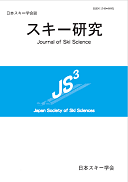This study aimed to identify technical issues to improve the competitive performance of junior female alpine skiing racers and compile useful information for considering systematic guidance guidelines. A questionnaire on the technical characteristics of junior female racers, targeting alpine skiing coaches with extensive experience in competitions and teaching, was conducted. The questionnaire included questions on “technical characteristics of top-level racers,” “technical issues of junior female racers,” “acquisition technical elements of junior female racers,” and “important teaching elements of the skiing technique.” The obtained responses were subjected to qualitative analysis using SCAT. The questionnaire results indicated that the technical elements of “accurate turn composition for course situations,” “accurate skiing,” “accurate positioning,” “accurate down weight motion,” and “accurate center of gravity shift” were necessary to achieve the highest level of competitive performance. The technical issues that junior female racers faced were “ski manipulation through physical movements dependent on ski performance” and “lack of experience in a variety of situations that lead to improved alpine skiing skills.” To establish the technical elements of top-level racers, the junior period, which is the stage of fine coordination, positioning, and turning movements to create high skiing speeds, was positioned as the instructional aim. The five instructional elements that contributed toward achieving this instructional aim included “skiing operation,” “basic posture,” “leg operation,” “center of gravity movement,” and “improvement of the limit speed.”
View full abstract
